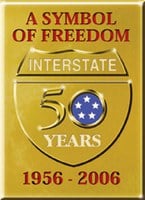50th Anniversary of the National System of Interstate and Defense Highways
Origins of the U.S. Interstate System
 Planning for what is now known as the Dwight D. Eisenhower system of Interstate and Defense Highways, commonly called the “Interstate System” began in the late 1930s as America began seeing light at the end of the tunnel of the Great Depression. The Federal Aid Highway Act of 1938 directed the Bureau of Public Roads (BPR), the predecessor of the Federal Highway Administration (FHWA) to study the feasibility of a toll financed system of three east-west and three north-south super highways. The BPR report, Toll Roads and Free Roads , concluded that a toll network would not be self-supporting. The report had a different recommendation – a 26,700 mile interregional highway network.
Planning for what is now known as the Dwight D. Eisenhower system of Interstate and Defense Highways, commonly called the “Interstate System” began in the late 1930s as America began seeing light at the end of the tunnel of the Great Depression. The Federal Aid Highway Act of 1938 directed the Bureau of Public Roads (BPR), the predecessor of the Federal Highway Administration (FHWA) to study the feasibility of a toll financed system of three east-west and three north-south super highways. The BPR report, Toll Roads and Free Roads , concluded that a toll network would not be self-supporting. The report had a different recommendation – a 26,700 mile interregional highway network.
In 1941, President Franklin D. Roosevelt appointed a National Interregional Highway Committee, headed by Commissioner of Public Roads Thomas H. MacDonald, to evaluate the nation for a national expressway system. The committee's report Interregional Highways , issued in January, 1944, supported a system of 33,900 miles, plus an additional 5,000 miles of auxiliary urban routes.
Designation of the System
In the Federal-Aid Highway Act of 1944, Congress acted on recommendations from Interregional Highways . The legislation called for designation of a National System of Interstate Highways, up to 40,000 miles in length, to connect principal metropolitan areas, cities, and industrial centers, to serve the National Defense, and to connect with routes of continental importance in Mexico and Canada at suitable border points.
On August 2, 1947, Commissioner MacDonald and Federal Works Administrator Philip B. Fleming announced the selection of the first 37,700 miles of routes, which had been proposed by state highway agencies and reviewed by the Department of Defense. There was just one problem, however – neither then 1944 act nor any later legislation in the 1940s authorized funds specifically for the Interstate System. Construction progress was predictably slow.
Interstate Highway Funding
Some reports from Colorado say that President Dwight D. Eisenhower was especially interested in an interstate highway system partially because of his experiences going back and forth between Denver to Fraser to fish. Traffic jams on old U.S. 6/U.S. 40 were nothing new in the area; reports say the President was stuck on several major jams on his way back from fish on Sunday evenings and felt an interstate system would take care of such problems in Colorado and elsewhere.
The Federal-Aid Highway Act of 1952 authorized the first funding specifically for System construction, but it was only a token amount of $25 million per year for FYs 54 and 55. Legislation in 1945 authorized an additional $175 million annually for FYs 56 and 57.
Under the leadership of President Eisenhower, the question of how to fund the Interstate System was resolved with enactment of the Federal-Aid Highway Act of 1956. It served as a catalyst for the System's development and, ultimately, its completion. Title I of the 1956 act increased the System's proposed length to 41,000 miles. It also called for nationwide standards for design of the System, authorized an accelerated program, established a new method for apportioning funds among the states, changed the name to the National System of Interstate and Defense Highways, and set the Federal Government's share of project cost at 90%.
Title II of the Act – entitled the Highway Revenue Act of 1956 – created the Highway Trust Fund as a dedicated source for funding the Interstate System.
Revenue from the Federal gas and other motor-vehicle user taxes was credited to the Highway Trust Fund to pay the Federal share of interstate and all other federal-aid highway projects. In this way, the Act guaranteed construction of all segments of the system on a “pay-as-you-go” basis, thus satisfying one of President Eisenhower's primary requirements, namely that the program be self-financing without contributing to a federal budget deficit.
Mileage Expanded
In 1968, the Federal-Aid Highway Act authorized the system's expansion to 42,500 miles. The designated system, scheduled for completion in the 1990s, would include approximately 42,795 miles, connecting 286 of 366 U.S. cities over 50,000 in population, 45 of the 50 state capitols, and the U.S. Capitol, Washington , D.C
